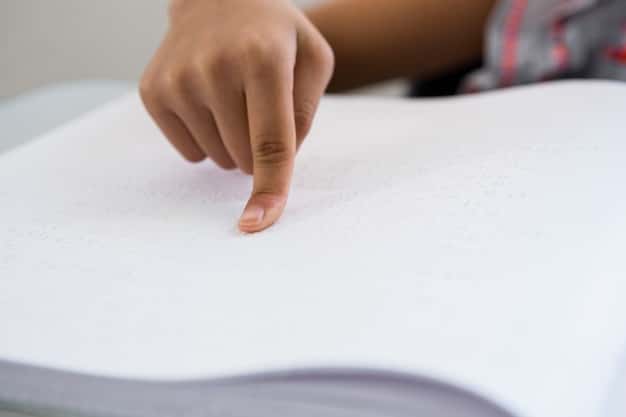Uncovering Hidden Biases in Standardized Tests: Impact on Minority Students

Insider knowledge reveals how standardized testing can perpetuate biases, disproportionately affecting minority students’ access to educational opportunities and equitable outcomes in the US.
Standardized tests are often seen as objective measures of academic ability, but insider knowledge reveals a more complex reality. This article delves into the hidden biases embedded within these tests and explores their disproportionate impact on minority students in the US.
The History of Standardized Testing and its Original Intent
Standardized testing has a long and complex history in the United States. Initially conceived as a tool for objective assessment and meritocratic selection, its roots and evolution reveal a more nuanced narrative.
Early Origins and the Rise of Standardized Testing
The concept of standardized testing gained traction in the early 20th century, driven by the need to efficiently evaluate large numbers of individuals. The original intent was to create fair and impartial measures of cognitive abilities and academic achievement.
- Army Alpha and Beta Tests: Developed during World War I to assess the intelligence of recruits, setting a precedent for large-scale standardized assessments.
- The Scholastic Aptitude Test (SAT): Introduced in 1926, initially aimed to provide unbiased assessments for college admissions, regardless of socioeconomic background.

The Shift in Purpose and Unintended Consequences
Over time, standardized testing became increasingly influential in shaping educational policies and opportunities. This shift in purpose also brought unintended consequences, particularly for minority students.
- Tracking and Sorting: Standardized tests began to be used to track students into different educational pathways, which often perpetuated socioeconomic and racial inequalities.
- High-Stakes Testing: The increased emphasis on standardized test scores for college admissions and school accountability led to a narrower curriculum and a focus on test preparation, potentially disadvantaging students from under-resourced schools.
The history of standardized testing reveals a complex evolution from its original intent to a more influential and sometimes problematic role in shaping educational opportunities. Understanding this history is crucial to addressing the hidden biases that persist in these assessments today.
Identifying Biases in Test Content and Format
One of the most significant challenges with standardized testing is the presence of biases embedded in the test content and format. These biases can systematically disadvantage minority students, affecting their scores and future opportunities.
Cultural Bias in Test Questions
Cultural bias refers to the presence of test questions that favor certain cultural backgrounds or experiences. These questions may assume knowledge or understanding that is more common among students from dominant cultural groups.
- Content Familiarity: Questions that reference specific cultural events, figures, or artifacts that are not widely known across different racial or ethnic groups.
- Language Nuances: The use of idiomatic expressions, slang, or vocabulary that may be unfamiliar to students who are not native English speakers or come from different linguistic backgrounds.
Format and Structure That Disadvantage Some Groups
The format and structure of standardized tests can also introduce biases that disproportionately affect minority students. Timed tests, multiple-choice formats, and abstract reasoning questions can all present challenges.
- Timed Tests: Students from under-resourced schools may have less experience with timed tests, leading to increased anxiety and reduced performance.
- Abstract Reasoning: Questions that require abstract reasoning skills may be more challenging for students who have not had the same opportunities to develop these skills through advanced coursework or enrichment programs.
By identifying and addressing these biases in test content and format, educators and policymakers can work towards creating more equitable and fair assessment tools for all students.

The Impact of Socioeconomic Factors on Test Performance
Socioeconomic factors play a significant role in shaping students’ test performance. Disparities in access to resources, quality of education, and home environment can all contribute to differences in standardized test scores.
Resource Disparities and Educational Opportunities
Students from low-income families often attend under-resourced schools, which can limit their access to quality education and enrichment opportunities. These disparities can affect their preparedness for standardized tests.
- Funding Gaps: Schools in low-income communities typically receive less funding, resulting in fewer resources such as updated textbooks, technology, and qualified teachers.
- Enrichment Programs: Affluent schools often offer a range of enrichment programs, such as advanced placement courses, tutoring services, and test preparation workshops, which are not available to students from under-resourced schools.
The Influence of Home Environment and Support Systems
The home environment and support systems available to students can also significantly impact their test performance. Factors such as parental education, family stability, and access to resources at home can all play a role.
- Parental Involvement: Students whose parents are actively involved in their education tend to perform better on standardized tests. However, parents from low-income families may face challenges such as limited time, language barriers, or lack of awareness about the educational system.
- Access to Resources: Having access to resources at home, such as books, computers, and a quiet study space, can also positively influence test performance. These resources are often scarce in low-income households.
Addressing the impact of socioeconomic factors on test performance requires comprehensive strategies that focus on reducing resource disparities, improving educational opportunities, and strengthening support systems for students from disadvantaged backgrounds.
Stereotype Threat and its Effects on Minority Students
Stereotype threat is a psychological phenomenon that occurs when individuals feel at risk of confirming negative stereotypes about their social group. This threat can impair performance on standardized tests, particularly for minority students.
Understanding Stereotype Threat
Stereotype threat is a situational predicament in which individuals are at risk of confirming negative stereotypes about their group. This can lead to anxiety, self-doubt, and reduced cognitive resources, ultimately affecting performance.
- Activation of Stereotypes: When minority students are reminded of negative stereotypes about their group’s intellectual abilities, they may experience increased anxiety and decreased self-confidence.
- Cognitive Interference: Stereotype threat can interfere with cognitive processes such as attention, memory, and problem-solving, making it more difficult to perform well on standardized tests.
Strategies for Reducing Stereotype Threat
There are several strategies that educators and test administrators can use to reduce the effects of stereotype threat on minority students. These strategies focus on creating a more supportive and inclusive testing environment.
- Affirmation Exercises: Encouraging students to affirm their values, strengths, and positive attributes before taking a test can boost their self-confidence and reduce anxiety.
- Role Models: Highlighting successful role models from minority groups can challenge negative stereotypes and inspire students to perform at their best.
By understanding and addressing stereotype threat, educators can create a more equitable testing environment and help minority students achieve their full potential on standardized tests.
The Role of Test Preparation and Access to Coaching
The availability of test preparation and coaching can significantly influence students’ performance on standardized tests. However, access to these resources is often unequal, with affluent students having a distinct advantage.
Unequal Access to Test Preparation Resources
Students from low-income families and under-resourced schools often lack access to high-quality test preparation resources, putting them at a disadvantage compared to their more affluent peers.
- Cost of Test Preparation: Comprehensive test preparation programs can be expensive, making them inaccessible to many low-income families.
- Availability of Resources: High-quality test preparation resources, such as experienced tutors, practice tests, and specialized courses, are often concentrated in affluent areas.
The Impact of Coaching on Test Scores
Test preparation and coaching can improve students’ test scores by familiarizing them with the test format, content, and strategies. However, the benefits of coaching may be limited for students who lack a strong foundation in core academic skills.
- Familiarity with Test Format: Coaching can help students become more comfortable with the test format, reducing anxiety and improving their time management skills.
- Strategy Development: Test preparation can teach students effective strategies for answering different types of questions, improving their accuracy and efficiency.
Addressing the unequal access to test preparation and coaching requires efforts to provide affordable and high-quality resources to students from all socioeconomic backgrounds. This can help level the playing field and ensure that all students have an opportunity to succeed on standardized tests.
Alternative Assessment Methods and Their Potential
Given the limitations and biases of standardized testing, there is growing interest in alternative assessment methods that offer a more comprehensive and equitable evaluation of students’ abilities. These methods focus on assessing a broader range of skills and knowledge, and they are often more aligned with authentic learning experiences.
Performance-Based Assessments
Performance-based assessments require students to demonstrate their skills and knowledge by completing a task or project. These assessments can provide a more authentic and meaningful evaluation of students’ abilities.
- Portfolios: Students compile a collection of their best work over time, showcasing their growth and development in specific areas.
- Projects: Students design and complete a project that requires them to apply their knowledge and skills to solve a real-world problem.
Multiple Measures of Assessment
Using multiple measures of assessment can provide a more comprehensive and nuanced understanding of students’ abilities. This approach involves combining different types of assessments, such as standardized tests, classroom assignments, and teacher evaluations.
- Holistic Review: Colleges and universities are increasingly adopting a holistic review process, which considers a range of factors beyond standardized test scores, such as GPA, essays, extracurricular activities, and letters of recommendation.
- Teacher Evaluations: Teacher evaluations can provide valuable insights into students’ abilities, work habits, and personal qualities, which are not captured by standardized tests.
Exploring and implementing alternative assessment methods can help create a more equitable and meaningful evaluation system that recognizes the diverse talents and abilities of all students.
| Key Point | Brief Description |
|---|---|
| 📚 Bias in Testing | Hidden biases in standardized tests affect minority students unfairly. |
| 💰 Socioeconomic Factors | Resource disparities impact test performance for low-income students. |
| 😥 Stereotype Threat | Negative stereotypes can hinder minority students’ test results. |
| 🔄 Alternative Assessments | Performance-based methods offer a fairer evaluation of skills. |
Frequently Asked Questions
▼
Standardized tests are exams administered and scored in a consistent, or “standard,” manner. They’re designed to evaluate knowledge or skills against a uniform benchmark.
▼
Minority students often face systemic barriers like stereotype threat and unequal access to resources, leading to lower scores that may misrepresent their abilities.
▼
Stereotype threat occurs when someone feels at risk of confirming negative stereotypes about their group, causing anxiety that can lower their test performance.
▼
Yes, performance-based assessments, portfolios, and holistic reviews provide broader evaluations of skills and potential, not just test scores.
▼
Efforts include culturally responsive test design, acknowledging socioeconomic factors, and promoting inclusive testing environments to mitigate stereotype threat.
Conclusion
Uncovering the hidden biases in standardized testing and understanding their disproportionate impact on minority students is crucial for promoting educational equity. By recognizing these biases and exploring alternative assessment methods, we can work towards creating a fairer and more inclusive system that values the diverse talents and abilities of all students.





